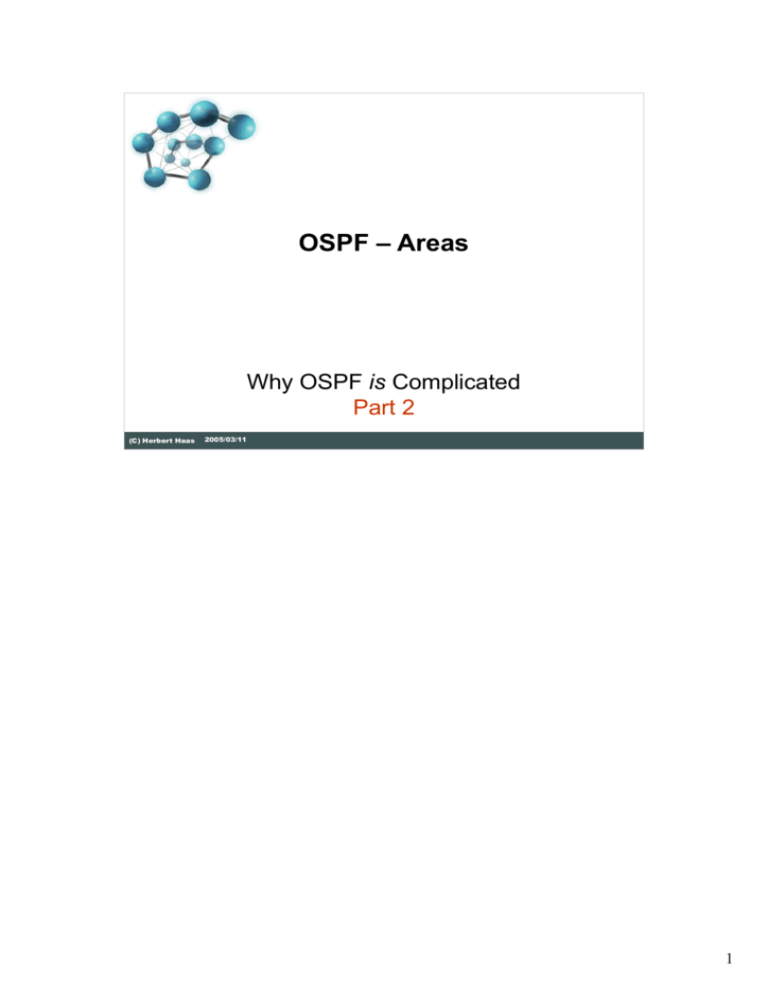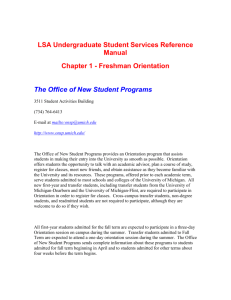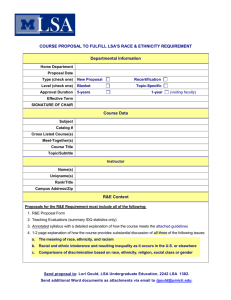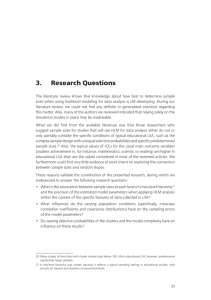Area 0
advertisement

OSPF Areas Why OSPF is Complicated Part 2 (C) Herbert Haas 2005/03/11 1 An algorithm must be seen to be believed Donald .E. Knuth 2 OSPF Areas To improve performance divide the whole OSPF domain in multiple Areas Restrict Router LSA and Network LSA within these Areas All areas must be connected to the so-called "Backbone Area" "Area 0" (C) Herbert Haas 2005/03/11 3 As each link is identified by a router LSA in the OSPF database, the total OSPF routing traffic increases with the number of links and thus with the size of the network. Also the amount of network LSA will increase in larger networks. The basic idea of OSPF to overcome these limitations is to partition the whole OSPF domain into smaller "areas". The basic idea is to filter router LSAs and network LSAs on the borders between areas. Network reachabilities from outside is advertised through other LSA types. These details are discussed next. 3 ABR Area Border Router (ABR): Terminates Router LSAs and Network LSAs Forwards Network Summary LSAs Area 0 LS A ABR 2 1 LS A LSA 2 2 LS A 1 Area 2 LSA 1 LSA 2 LSA 3 3 LS A A LS LS A 3 1 LSA 3 LS A A LS Area 1 ABR ABR 3 LS 3 LSA 3 A3 LS A LSA 3 Note: Network Summary LSAs are Distance Vector updates !!! Area 5 Router LSA Network LSA Network Summary LSA (C) Herbert Haas 2005/03/11 4 Traffic from one area to another area flows through dedicated routers only, so called Area Border Routers (ABRs). The ABRs filter Router LSAs and Network LSAs. Network destinations in other areas are advertised by so-called "Network Summary LSAs", which carry simple distance-vector information i. e. which networks can be reached by which ABR. Actually, we will deal with the following OSPF router types: Internal Routers (IR): Has all interfaces inside an area Backbone Routers (BR): Has at least one interface in the backbone area Area Border Routers (ABR): Has interfaces in at least two areas Autonomous System Boundary Routers (ASBR): Has at least one interface in a non-OSPF domain; redistributes external routes into the OSPF domain ASBRs are discussed next. 4 ASBR When an ABR receives an AS External LSA it emits ASBR Summary LSAs to all routers Autonomous System Border Router (ASBR) A LS LSA 4 LSA 2 LSA 3 Router LSA Network LSA Network Summary LSA (C) Herbert Haas 5 ABR LS A 5 A LS ASBR 5 LSA 4 LSA 5 LS A 5 LSA 4 LSA 5 Area 2 LSA 1 LS A 4 LS A 5 LS A Area 1 LSA 5 5 5 A LS 4 ABR LS A LS A LS ABR A4 L SA 4 LSA 5 Area 0 5 Imports foreign routes via AS External LSA Area 5 ASBR Summary LSA AS External LSA 2005/03/11 5 An Autonomous System Border Router (ASBR) sends the summary information about foreign networks to OSPF networks, using LSA type 5. On ASBRs you have to run 2 routing processes: OSPF and some other routing protocolthe router redistributes routing infomation between OSPF and other routing process. 5 Stub Area Area 0 A LS 5 LSA 3 LS A Router LSA Network LSA Network Summary LSA (C) Herbert Haas 2005/03/11 5 A LS ASBR 5 5 Stub Area 2 LSA 3 LS A 3 Area 1 LSA 2 ABR ABR 1 LSA LSA 1 5 LSA 4 LSA 5 AS External LSA and ASBR Summary LSA are not sent into a Stub Area LS A LS LSA 4 3 2 LS A A LS A LS ABR A4 3 LSA Area 5 ASBR Summary LSA AS External LSA 6 An ASBR could send a lot of external routes, tose will be flooded into OSPF network. ABRs propogate this information into other OSPF areas, each router in the area knows all external links and they are stored in link state database. In order to reach the external destination, the router still needs to send a packet to ABR. We can make a database of internal router smaller, if we create a stub area. A stub area means that ABR does not sent an external LSAs into this area, instead ABR advertises a default route (0.0.0.0) 6 Totally Stubby Area Cisco Specific Area 0 2 LS A LS 5 LS A LSA 4 5 ABR ABR A LS A LS ABR A4 3 LSA LS A 5 3 1 LSA LSA 2 LSA 3 LS A Area 1 LSA 1 Totally Stubby Area 2 Router LSA Network LSA Network Summary LSA (C) Herbert Haas ASBR 5 5 A LS LSA 4 LSA 5 No external or summary LSA are sent into a Totally Stubby Area Area 5 ASBR Summary LSA AS External LSA 2005/03/11 7 A Ciscos propritary extention to the Stub Area. The ABR will not advertise an external LSAs, like into a stub area, in addition ABR will not send a summary LSAs from other areas, instead a default route is injected into Totally Stubby area. 7 Not So Stubby Area (NSSA) ABR will translate the Type 7 LSA into a Type 5 LSA only if the Type 7 LSA has the P-bit set to 1 5 LSA 3 LS A NSSA Area 2 Router LSA Network LSA Network Summary LSA A LS 5 ASBR 5 5 ASBR advertizes routes of another routing domain via NSSA External LSA LSA 4 LSA 5 LSA 7 (C) Herbert Haas LS A 3 ASBR LSA 3 ABR 7 LSA LSA 7 Area 1 LSA 2 5 ABR 1 LSA LSA 1 LSA 4 LS A A LS LS A LS 3 2 3 LSA A LS A LS ABR A4 LS A 5 Area 0 Area 5 ASBR Summary LSA AS External LSA NSSA External LSA 2005/03/11 8 The NSSA ASBR has the option of setting or clearing the P-bit in the NSSA External LSA. If the P-bit is set any ABR will translate this LSA into an AS External LSA (Type 5). 8 Summarization Efficient OSPF address design requires hierarchical addressing Address plan should support summarization at ABRs 20.1.0.0/16 ... 20.254.0.0/16 Area 10 22 /8 21/8 Area 0 20/8 21.1.0.0/16 ... 21.254.0.0/16 22.1.0.0/16 ... 22.254.0.0/16 Area 30 Area 20 (C) Herbert Haas 2005/03/11 9 Summarization is an other way to keep a router database smaller. The ABR instead of sending each single subnet from the area, creates a summary route and advertises it into a different area. Note that summarization is turned off by default (i. e. must be explicitly turned on). 9 Virtual Links Another way to connect to area 0 using a point-to-point unicast tunnel Transit area must have full routing information Area 0 ABR Virtual Link Area 1 ABR Must not be stub area Bad Design! (C) Herbert Haas Area 2 2005/03/11 10 An OSPF design requires that all areas have to be contiguous and must be connected to the backbone area. If it is not a case, like on the slide, you have to use a Virtual Link in order to connect area 2 to area 0 A virtual link is considered as part of area 0 thus the area ID is 0.0.0.0. 10 Virtual Link Example Now router 3.3.3.3 has an interface in area 0 Thus router 3.3.3.3 becomes an ABR Generates summary LSA for network 7.0.0.0/8 into area 1 and area 0 Also summary LSAs in area 2 for all the information it learned from areas 0 and 1 (C) Herbert Haas Area 0 4.0.0.1 Router 1.1.1.1 Area 1 5.0.0.1 Router 2.2.2.2 5.0.0.2 6.0.0.2 6.0.0.3 Router 3.3.3.3 7.0.0.3 Area 2 2005/03/11 11 A router 3.3.3.3 is now connected to area 0 directly and like a normal ABR generates a summary LSAs in both directions 11 Virtual Link Configuration Example router ospf 5 network 4.0.0.0 0.255.255.255 area 0 network 5.0.0.0 0.255.255.255 area 1 area 1 virtual-link 3.3.3.3 Area 0 4.0.0.1 Router 1.1.1.1 Area 1 5.0.0.1 Router 2.2.2.2 5.0.0.2 6.0.0.2 router ospf 5 network 7.0.0.0 0.255.255.255 area 2 network 6.0.0.0 0.255.255.255 area 1 area 1 virtual-link 1.1.1.1 6.0.0.3 Router 3.3.3.3 7.0.0.3 Area 2 (C) Herbert Haas 2005/03/11 12 Note virtual link goes to a router ID on the other end not to an ip address on the interface 12 GRE instead of Virtual Link Alternative solution Good: Transit area can be a also a stub area Bad: All traffic is encapsulated Not only routing traffic Increased overhead (C) Herbert Haas 2005/03/11 13 In some cases it is not possible to use a virtual link, as a possible solution ap ip tunnel could be implemented. 13 Summary Area concept supports large networks Keeps topology table small Reduces routing traffic But additional LSA types necessary Inter-Area Routing is Distance Vector Originally OSPF designed for ToS routing too resource greedy! (C) Herbert Haas 2005/03/11 14 14 Quiz When should we split the OSPF domain into areas? What about Areas and addressing plans? Why must all areas be connected to the backbone area? (C) Herbert Haas 2005/03/11 15 15







